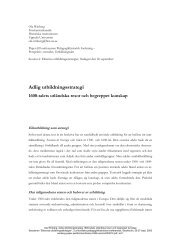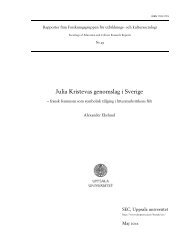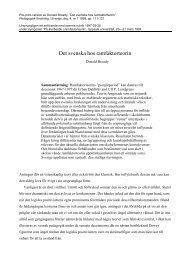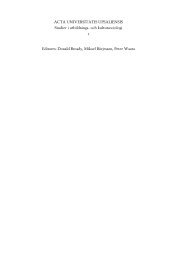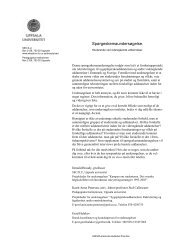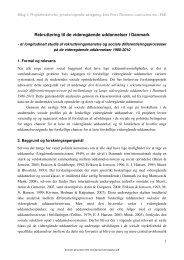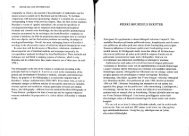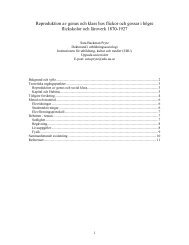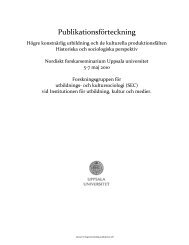exploring uses of digital archives in research and ... - skeptron.uu.se
exploring uses of digital archives in research and ... - skeptron.uu.se
exploring uses of digital archives in research and ... - skeptron.uu.se
Create successful ePaper yourself
Turn your PDF publications into a flip-book with our unique Google optimized e-Paper software.
k<strong>in</strong>ds <strong>of</strong> data, such as numerical <strong>se</strong>quences <strong>and</strong> databa<strong>se</strong> l<strong>in</strong>ks s<strong>in</strong>ce I am plann<strong>in</strong>g to do acomparative ca<strong>se</strong> study <strong>of</strong> two different <strong>re<strong>se</strong>arch</strong> communities, the Text Encod<strong>in</strong>g Initiative<strong>in</strong> the humanities <strong>and</strong> the bio<strong>in</strong>formatics <strong>in</strong> the natural sciences.Re<strong>se</strong>arch questionsThe <strong>in</strong>terrelated but yet st<strong>and</strong>alone studies will be guided by the follow<strong>in</strong>g questions <strong>and</strong>sub-questions:• How might teachers <strong>and</strong> students benefit from emerg<strong>in</strong>g mark-up <strong>and</strong> metadatarecommendations <strong>and</strong> st<strong>and</strong>ards?How might <strong>digital</strong> <strong>archives</strong> be designed allow<strong>in</strong>g teachers <strong>and</strong> students flexiblemodes <strong>of</strong> access to <strong>and</strong> u<strong>se</strong> <strong>of</strong> the content there<strong>in</strong>?• How does the terra<strong>in</strong> look like <strong>of</strong> <strong>in</strong> the <strong>u<strong>se</strong>s</strong> <strong>of</strong> <strong>digital</strong> <strong>archives</strong> for humanities <strong>and</strong>social science <strong>re<strong>se</strong>arch</strong> <strong>and</strong> education?How is the complexity <strong>of</strong> design<strong>in</strong>g <strong>and</strong> prepar<strong>in</strong>g different k<strong>in</strong>ds <strong>of</strong> contenth<strong>and</strong>led? What strategies, pr<strong>in</strong>ciples <strong>and</strong> <strong>in</strong>terests <strong>in</strong>form their orientations?• How do <strong>re<strong>se</strong>arch</strong> communities make u<strong>se</strong> <strong>of</strong> <strong>digital</strong> <strong>archives</strong> <strong>and</strong> web repositories?How do <strong>re<strong>se</strong>arch</strong>ers actually work with their tools <strong>and</strong> methods <strong>in</strong> the humanitiescommunities on the one h<strong>and</strong> <strong>and</strong> the natural sciences on the other h<strong>and</strong>?The problems, context <strong>and</strong> delimitationsAbove I have tried to argue for why it might be important to study how <strong>digital</strong> <strong>archives</strong> <strong>and</strong><strong>digital</strong> content are designed, managed <strong>and</strong> utilized <strong>in</strong> <strong>re<strong>se</strong>arch</strong> but not yet discus<strong>se</strong>d <strong>in</strong> whatway it might relate to teach<strong>in</strong>g <strong>in</strong> higher education. Below, I will discuss some pedagogicalaspects on the relation between personal portfolios <strong>and</strong> shared repositories <strong>and</strong> how <strong>digital</strong><strong>archives</strong> might be designed to allow teachers <strong>and</strong> students to access, retrieve <strong>and</strong> u<strong>se</strong> thatcontent <strong>in</strong> different ways. I also want to give a brief overview <strong>of</strong> emerg<strong>in</strong>g mark-up <strong>and</strong>st<strong>and</strong>ardization efforts <strong>and</strong> <strong>in</strong>itiatives with relevance for educational <strong>se</strong>tt<strong>in</strong>gs. And last butnot least the issue <strong>of</strong> u<strong>se</strong> <strong>of</strong> <strong>digital</strong> <strong>archives</strong> <strong>and</strong> the practices <strong>of</strong> content design <strong>in</strong> some<strong>re<strong>se</strong>arch</strong> communities. This could <strong>of</strong> cour<strong>se</strong> be studied <strong>in</strong> a number <strong>of</strong> ways <strong>and</strong> I will try tounfold the issues <strong>in</strong>herent <strong>in</strong> the questions above by us<strong>in</strong>g three <strong>in</strong>terl<strong>in</strong>k<strong>in</strong>g str<strong>and</strong>s. My<strong>in</strong>tention is that the<strong>se</strong> str<strong>and</strong>s will <strong>se</strong>rve as means to discern what k<strong>in</strong>d <strong>of</strong> assumptions,levels <strong>and</strong> relationships I could be deal<strong>in</strong>g with <strong>in</strong> my forthcom<strong>in</strong>g studies.Content: the nature <strong>of</strong> <strong>in</strong>formation utili<strong>se</strong>d <strong>and</strong> studied by scholars <strong>and</strong> teachers can bealmost anyth<strong>in</strong>g <strong>and</strong> the <strong>in</strong>formation can be studied for many different reasons <strong>and</strong>purpo<strong>se</strong>s. Thus, digitization <strong>of</strong> content, <strong>in</strong>formation <strong>and</strong> source material <strong>in</strong>volves somefundamental decisions: what is consider<strong>in</strong>g be<strong>in</strong>g the data. 17 In this ca<strong>se</strong>, content willprimarily be equivalent with texts but to some extent other k<strong>in</strong>ds <strong>of</strong> data as mentionedabove. 1817 When Willard McCarty (2002) discuss what happens when source materials (<strong>in</strong> the humanities) arecomputerized he stres<strong>se</strong>s the <strong>in</strong>teraction tak<strong>in</strong>g place dur<strong>in</strong>g the process <strong>of</strong> <strong>se</strong>lection <strong>and</strong> choos<strong>in</strong>g what isconsider to be the data. The difficult part <strong>in</strong> construction <strong>of</strong> computerized source material is the <strong>in</strong>evitabledifference between human knowledge <strong>of</strong> <strong>and</strong> declarative statements about specific objects (i.e. the data).18 I will not – at this stage anyway – discuss or attempt to elucidate what a text is or might be. I leave thisdiscussion for the moment <strong>and</strong> <strong>in</strong>stead treat the notion <strong>of</strong> text from a pragmatic <strong>and</strong> rather unproblematicview s<strong>in</strong>ce my <strong>in</strong>terest is with<strong>in</strong> <strong>u<strong>se</strong>s</strong>, manipulation <strong>and</strong> applications <strong>of</strong> electronic texts. Namely, when talk<strong>in</strong>gabout texts I refer to signs organi<strong>se</strong>d as <strong>in</strong>formation <strong>and</strong> repre<strong>se</strong>ntation <strong>of</strong> any content. A l<strong>in</strong>guistic def<strong>in</strong>itioncould be: “a text is a <strong>se</strong>quence <strong>of</strong> paragraphs that repre<strong>se</strong>nts an extended unit <strong>of</strong> speech” (Glossary <strong>of</strong>l<strong>in</strong>guistic terms, http://www.sil.org/l<strong>in</strong>guistics/GlossaryOfL<strong>in</strong>guisticTerms/Index.htm [2003-04-07]).pm-030505.doc utkast avh.pm. Monica Langerth Zetterman 5(34)



